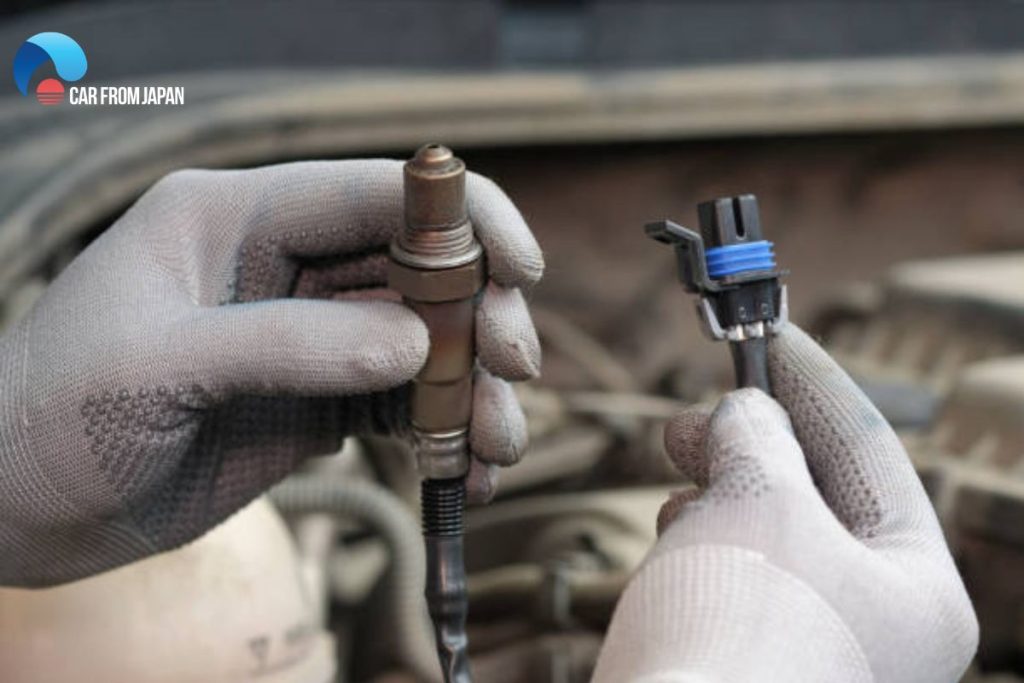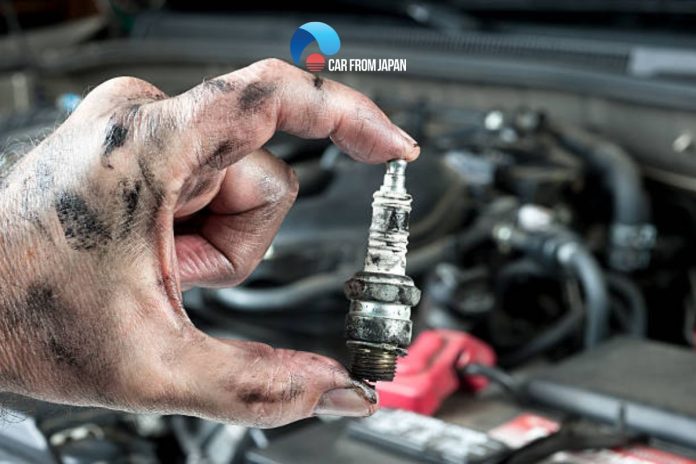If your engine is running rough, misfiring, or struggling to accelerate, one of the first things to check is your spark plugs. Pulling one out and finding it covered in a dry, black, sooty deposit means you’ve got a carbon fouled spark plug. This isn’t just a cosmetic issue; it’s a sign your engine isn’t burning fuel correctly. We’re here to help you identify the causes behind this common issue and explore effective solutions.
Contents
The Importance Of A Spark Plug In Your Car
A spark plug is a part of the ignition system, which plays an important role in the operation of the engine. Automotive spark plugs have the effect of generating an electric spark between the center electrode and the electrode of the grounding side to help ignite the fuel in the cylinder.
Spark plugs operate in conditions of compression pressure up to 50 kg/cm2 and the ambient temperature around 2,500°C. Therefore, spark plugs need to have high durability and achieve high pressure and heat resistance. Meeting this requirement, the new spark plug can give a strong spark, helping to maintain the stable operation of the engine.
As a part that works directly and comes into contact with the engine’s combustion chamber, any problem with the spark plug can have a serious impact on the engine’s operation, like poor acceleration, engine misfire, and rough idling…

What Are The Reasons Behind When Carbon-Fouled Spark Plugs?
A spark plug is considered fouled when the insulator nose at the firing tip becomes coated with shiny soot or carbon. This coating makes it easier for the voltage to follow the insulator nose leak back down into the metal shell and ground out rather than bridging the gap in firing.
The consequence is having many adverse effects on the performance of your vehicle. Reading this far, many readers will wonder where carbon is formed and why it appears in the engine combustion chamber. Take a moment to learn about this.
Causes of carbon soot formation in the combustion chamber.
During the driving process, the engine burns fuel (gasoline, oil) in the cylinder, but because the amount of oxygen supplied to the cylinder is not enough for the combustion process, the fuel burns incompletely to form toxic substances such as CO, HC, CO, PM… and especially carbon black.
The soot in the cylinder meets the environment with high temperature and pressure to form fine particles, with high hardness, clinging to the valve, piston head, cylinder wall, and spark plug…
Because carbon particles have a high hardness that causes cylinder scratches, along with an increasingly thick layer of soot, which changes the compression ratio of the engine, etc. This is the cause of the engine not being effective, sluggish, loud noise, followed by the process of acceleration and deceleration jerking.
What causes a fouled spark plug?
To be able to come up with a complete solution for the carbon buildup on spark plug. We need to know the reasons for this problem:
A dirty air filter

An air filter works in your car as a guard to protect the engine from dirt or other contaminants in the air before they enter your engine. With regular use, the filter can easily get dirty and lose its key function to clean the air.
As a result, it will limit the airflow and reduce oxygen in the mixture and excess fuel because there’s not enough air in your engine. The fuel does not completely burn in the combustion chamber, which will cause a carbon deposit on the layer of the spark plug.
Faulty fuel injector
When a fuel injector gets dirty or loses its function, it will directly affect the amount of fuel entering the cylinder, sometimes too much or no fuel at all. The main function of the injector is to directly inject fuel into the engine cylinder combustion chamber to create ignition.
A dirty fuel injector will make the combustion of a mixture of gas and fuel effective. And create the spot that sticks on the spark plug due to ineffective burning in the combustion chamber.
Too rich air mixture
Over time for some reason, you will notice the excessive air or fuel mixture in your engine while there’s not enough air. At that time, the automobile engine will burn them off, and the excess carbon from the fuel will clog and form a deposit on the spark plug, and you can smell the sulfur odor from your car.
Failed oxygen sensor
Although the oxygen sensor is a relatively small part, it plays a vital role in the engine system and can prevent more costly problems. This sensor is responsible for checking the air and fuel ratio in the engine so that the computer can make adjustments if necessary.
The amount of oxygen in the engine will depend on many factors, such as air temperature in the combustion chamber, load, and pressure. If you have a faulty oxygen sensor, it could be sending a false rich or lean condition to the ECM, and the ECM will respond by adding more or less fuel. That’s the reason for the dirty spark plugs.

Idling your vehicle for too long
Idling is not harmful to your car, but it can make your spark plugs build up carbon deposits. When your car doesn’t drive for a long time, it means that no combustion of carbon and fuel occurs. Many people think that idling is an efficient way to warm up the engine, but it’s not true. Because your car is made up of many moving components. A better way you can use to heat up your car’s transmission, tires, and suspension is to drive slowly. Your car tends to warm up faster this way.
What Are The Symptoms Of Carbon Fouled Spark Plug?
Through some simple symptoms, you can diagnose whether the spark plugs are clogged with carbon deposits. Because it plays an important role in the engine’s work process, if the spark plug is dirty or fouled, it will greatly affect the performance of your engine. Well below is the carbon fouled spark plug symptoms:
Engine performance declining: When the driver steps on the accelerator to accelerate the car, the ECM will control the spark plug to create a strong spark to ignite more fuel, more effective work. However, if the spark plug is fouled by black soot… the spark will lose its function and cause your engine to operate weakly.
Cost more fuel: If your car is consuming more fuel than usual, the spark plug is likely having a problem. Because when the spark plugs fail, the engine control ECM will not be able to control the spark intensity or the amount of oxygen to add to the right fuel level. This makes the combustion process less efficient.
“Check engine” light comes on: The Check Engine light is the engine fault light. When the engine or some related parts have any problems, the Check Engine light will illuminate to notify the driver. If you see the Check Engine light blinking, the spark plug is likely faulty.
How To Prevent Carbon Fouling?
“Faulty” spark plugs cause fuel combustion efficiency to decrease by up to 30%. It can be said that prevention methods are a good way to prevent excess carbon form from developing in your spark plug and car engine. Follow some tips below to keep spark plugs shiny:
Clean spark plugs
The best way to prevent the carbon-fouled spark plug is to directly check the condition of the spark plug. When removing the spark plug to check, use a clean, soft cloth to clean the area around the spark plug pin. Use a dry spray to clean all the dirt accumulated in the spark plug.
In the case of newly formed black soot, drivers can use a direct washing additive to clean, saving money and time. If carbon soot forms large, “stubborn” plaques, it is necessary to take the car to a reputable garage. Here, technicians use specialized camera equipment to check the engine, determine the condition, and give appropriate treatment.
Replacing new spark plugs
If the accumulation of carbon deposits has not built up too much at the tips, you can clean the electrodes and reinstall the spark plug, but sometimes just cleaning spark plugs is not enough. And replacing it with a new one is also a good solution.
Step 1: Remove spark plug wire
Before removing the wire, you should use tape or some symbols to mark the position; otherwise, the spark plugs will not ignite in the correct order. You can then use the appropriate tool for each type of spark plug to remove it.
Step 2: Set spark plug electrode distance
Most new spark plugs come with a pre-set electrode distance from the manufacturer. However, you should still check to make sure the spark plug’s electrical distance is in the range of 0.6-0.7 mm. If the gap is too wide, it will be difficult for sparks to pass through, and vice versa; if the gap is narrow, the spark will not be large enough for the mixture to ignite, and your car will consume more fuel.
Step 3: Install a new spark plug
Turn the spark plug by hand until it feels tight, then use the connecting rod to tighten the spark plug with enough force according to the specifications. You should check the instructions for proper mounting. Gaskets usually only need to be turned 1/4 to half a twist to be tight, but for the gasketless type, it will require more twists.
Clean air filter
A clogged or dirty air filter is the reason to prevents the air from entering the carburetor. When there’s not enough air in the chamber for combustion, your engine will run on a fuel-rich mixture, and carbon buildup is an inevitable thing. So, cleaning or replacing the air filter is your choice.
In addition to the above ways, many drivers shared with us that to avoid the carbon deposit, you should drive the car at a speed of approximately 80-90 km/h for about 10 minutes. This action can help you increase the temperature of spark plugs and partly remove the carbon soot or scale.
Watch more:
How Often Should You Clean Or Replace Spark Plugs?
According to many tips from experts, you should replace the car spark plugs after 40,000 – 100,000 km of operation. However, it is difficult to have an exact number of times when it is necessary to change car spark plugs. Spark plug life will depend on each type of spark plug, operating level, operating conditions, and maintenance mode.
The best way to know when to replace car spark plugs is to check, maintain, and clean car spark plugs periodically, every 20,000 km. Checking and cleaning spark plugs periodically not only helps prolong the life of spark plugs, and knowing when to replace new spark plugs. But also helps the engine to always operate in the best state. Because of the condition of the spark plugs, you can assess the condition of the engine.
Besides, if the period for periodic inspection is not yet due, but the car engine has abnormal signs, it is also necessary to check the spark plugs. Because most likely the spark plugs are going bad, expired, and need to be replaced.
The Bottom Lines
So, when you encounter a carbon-crowded spark plug, remember it’s more than just a dirty component; it’s a direct indicator that something in your engine’s operation needs adjustment. By carefully investigating the causes– from fuel system problems to ignition issues – and applying the correct solutions, you’re not just cleaning a plug. You’re taking vital steps to restore your engine’s proper c



